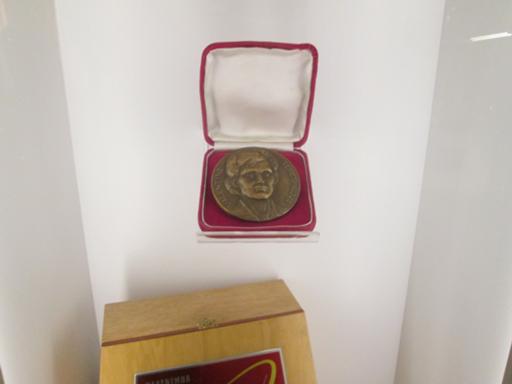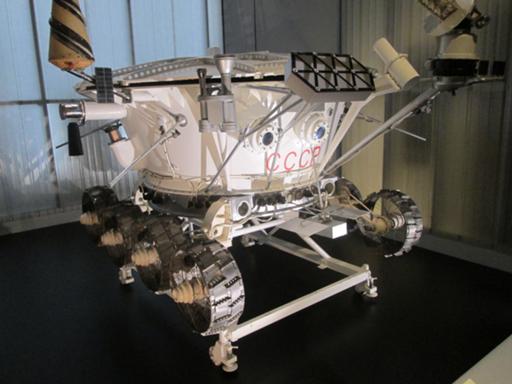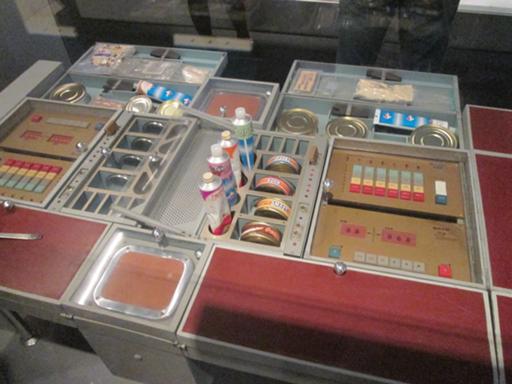Since yesterday was the Boxing Day Bank Holiday, I went to the Science
Museum for their Cosmonauts exhibition. Images follow:
cc-by-sa on
everything. (I'd been told photography was prohibited, but there were
no signs and nobody tried to stop me. I didn't use flash, which may
have helped.)
Sputnik 3 engineering
model.


Luna 9?
and Luna 16 ⅓-scale models.

Vostok 1 control panel (a very 1950s interface design, especially the
position indicator).

Vostok 1 ejection seat mockup.

Vostok 1 ⅓-scale model.

Glory to Gagarin! A fairy-tale come true!

Our space!

Commemorative plaques and medal for Valentina Tereshkova's flight
aboard Vostok 6.


Vostok 6, the actual flight article.


Voskhod 1, the actual flight article. Basically the same shell as the
Vostoks (developed as the Zenith observation satellite), but somehow
cramming in three people.


More fine propaganda posters.

The reason I came. LK-3, one of the five
LK lunar lander
prototypes. An interesting design decision: deorbit is done with the
Block D engine, while landing is done with the Block E; if that
doesn't start, you have an urgent problem. On the other hand there's a
reserve ascent engine, not an option for the LEM.






Lunokhod-1
engineering model.

Soyuz TM-14 (from the 14th Mir mission). Note the connectors in the
lower right of the first photo; each of them has about fifty
electrical pins…


Neptun main control panel from the Soyuz-T

Orlan pressure suits: Mars-500 and DMA-18, the latter with SPK 21KS
manoeuvreing pack.

Two Sokol KV2 suits (the upright one is the article worn by Helen
Sharman in 1991), and Kazbek-UM shock-absorbing seats.

Main table from Mir (note suction area in middle) and various
foodstuffs. I am not convinced by tinned omelette, though caviare
(ikra) should work very well, being sticky already.

Various zero-G tools. There's not really much you can do to a hammer.

Human-analogue fitted with radiation detectors and sent round the
Moon.

- Posted by Owen Smith at
12:49pm on
29 December 2015
I intend going to the exhibition, glad to see it's worthwhile.
Everyone focusses on these lunar engines possibly not lighing. But they're hypergollic, there is very little that can go wrong with them. The LEM ascent engine was deliberatly not throttleable to reduce complexity(and weight), if the valves open and there is pressure in the propellant tanks then it lights.
- Posted by RogerBW at
01:59pm on
29 December 2015
For me the key point is Actual Physical Stuff; I've met a lot of the American kit (both here and in the USA) and it's always fascinating to get impressions of real sizes, something that photographs don't always do well.
There's a remarkable amount of art in there too, including sketches from Tsiolkovskiy's notebooks, which is interesting but didn't make good photographic subjects.
John was pointing out that if the LEM ascent stage doesn't light, you have plenty of time to think about it and try to fix it; if the descent engine fails first time, you don't de-orbit. If the Block E doesn't light during landing, you're going to crash into the Moon, and your problem is time-limited.
- Posted by Owen Smith at
07:01pm on
29 December 2015
Now I understand, it's the urgency with which you need to fix the Block E not lighting that's critical. If it doesn't light can you abort with staging ie. using the ascent engine? That was an option on the LEM.
Actual Physical Stuff is indeed important. I was at the science museum earlier this year with my parents and went to look at the Apollo 10 actual capsule and the mockup of the LEM. One of my parents was surprised how small the LEM was, and the other how large it was. It was about what I expected since I've done a lot of reading on the Apollo hardware.
I'm looking forward to comparing the LK to the LEM, I expect the LK to be a lot smaller being a 1 man vehicle and given the much tighter weight buget the soviet moon hardware had.
The problem with seeing the US rockets is they're all in the US, and Homeland Security doesn't seem to want anyone to visit. I'd love to see them, but I'm wary about visiting the US and resent what they put people through on entry to the country. Do you still have to enter wearing only your underwear?
- Posted by RogerBW at
07:39pm on
29 December 2015
The Block E is the ascent engine. I suspect the redundancy of having multiple rockets is meant to let you fire some of them and at least get yourself into a non-lithobraking orbit.
(There was a blurb outside about "daring technological innovations" and I thought that "daring" had rarely been so accurately used.)
The LK is probably about ⅔ the height of a LEM. Although it's obviously a lot lighter because of that, it doesn't look weight-stripped the way a LEM does; all those exposed pipes (see e.g. the left side of my first photo) reminded me of the Green Mace unit that we saw at Firepower back in May. (There was a plan for a two-man version, and having seen Voskhod I can guess how they'd have done it.)
I've found the same size effect with aircraft: a Lysander is big when you meet one in person, compared with a Spitfire or a modern high-wing, in a way that photographs mostly don't show.
I haven't been to the USA since 2003 and have no plans to return.
Comments on this post are now closed. If you have particular grounds for adding a late comment, comment on a more recent post quoting the URL of this one.